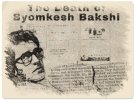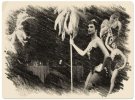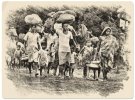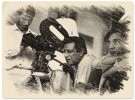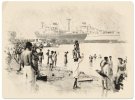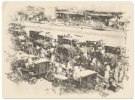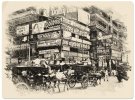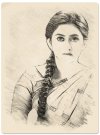View attachment 110590
"Byomkesh da ar nei?" A young man standing at a coffee shop, spoke to the old stall keeper "... E ki kobe khobor elo? Ki kore" he continued, the old stall keeper wipes his glasses and then spoke back in a shaky tone " ar ki bolbo dada, matro 30 bochor boyesh, ekta dangerous loker pechone giye nijer pran ta hariye phelen". The young man showed a noticable shock " ki bolchen apni ?? Eto boro detective ... Sorry Satanweshi nijer pran hariye phellen. Ekhon ki hobe? Onar toh Stree o ache?" The stall keeper listens and then responds back, " hai achen, satyabati onek jon bolen uni bhenge porechen, ei kom boyeshe bor harano, ar oder kono bachao toh nei. Satyabati boudi ekhon puro eka, hain ekta jinish ache onar modhe , majhe majhe uni nijer shamir shate ko ekta case solve korechilen, ekhon dekhi unio jodi detective er kaj koren". As the two talk the entire city is at a halt at the loss of their favorite crime solver and truth seeker.
Prologue: the city of joy, Calcutta 1960
The year is 1960, The nightlife culture of Calcutta in the 1960s was an integral part of the sophisticated lifestyle of the elite and the rich. Park Street was the most happening place to spend out nights partying till wee hours
.
View attachment 110589
Cultured men and women from the upper reaches of society used to sweep down Park Street in their swanky cars and dance to the music of live bands at Blue Fox, Mocambo, Moulin Rouge and other restaurants of those times. Guests on a visit to Calcutta from Japan, Singapore, Hong Kong, Bangkok and Manila were treated to the musical beats, fairy lights, and winey flavors of Park Street in the dead of night, in the 1960s.
View attachment 110591
Calcutta in the 1960s was a city of political upheavals, mass agitation, labor strikes and student unions’ protests. The turbulent being of the city served as the base of the Left’s rise in
West Bengal. Deindustrialization of the state began to take place in the 1960s leaving the next generations high and dry. The Naxalite movement, led by the fuming youth of Calcutta in the 1960s, triggered the political agitation. A massive flow of starved, penniless refugees from East Pakistan (now Bangladesh) during the onset of the Liberation War of 1971 added to Calcutta’s socio-political stagnation.
View attachment 110592
In the 1960s, Calcutta was a city of middle-class intellectuals. The professionals including doctors, professors, lawyers, filmmakers, engineers, managers and artists belonged to this class of the then Bengali society. The British had created this intellectual class to support and expand their trade when Calcutta was the capital of India.
View attachment 110593
The Hooghly riverfront of Calcutta was a thriving industrial belt till the mid of the 1960s. Howrah was the throbbing center of industrialization in the northeast before and after independence. Calcutta was the second best port city, next to Singapore, in Asia. The then industrial recognition of Calcutta as one of the global leaders was based on the production and export of jute and tea. The Ranigang-Asansol-Durgapur belt with coal mines and manufacturing plants was known as the Ruhr of India.
View attachment 110594
The public transport lifeline of Calcutta in the 1960s consisted of
hand-pulled rickshaws, double-decker buses, and
trams.
View attachment 110596
Now we come to Howrah, a place called Harrison road, in a three storey home a lady stands near the window, her husband recently passed away, and she has a open diary in her hand. Her husband had writen every single step and plans which she needs to follow in the event of his death, he wanted his wife to be a truthseeker like him and leave his legacy to her
View attachment 110597
...To be Cont
View attachment 110590
"Byomkesh da ar nei?" A young man standing at a coffee shop, spoke to the old stall keeper "... E ki kobe khobor elo? Ki kore" he continued, the old stall keeper wipes his glasses and then spoke back in a shaky tone " ar ki bolbo dada, matro 30 bochor boyesh, ekta dangerous loker pechone giye nijer pran ta hariye phelen". The young man showed a noticable shock " ki bolchen apni ?? Eto boro detective ... Sorry Satanweshi nijer pran hariye phellen. Ekhon ki hobe? Onar toh Stree o ache?" The stall keeper listens and then responds back, " hai achen, satyabati onek jon bolen uni bhenge porechen, ei kom boyeshe bor harano, ar oder kono bachao toh nei. Satyabati boudi ekhon puro eka, hain ekta jinish ache onar modhe , majhe majhe uni nijer shamir shate ko ekta case solve korechilen, ekhon dekhi unio jodi detective er kaj koren". As the two talk the entire city is at a halt at the loss of their favorite crime solver and truth seeker.
Prologue: the city of joy, Calcutta 1960
The year is 1960, The nightlife culture of Calcutta in the 1960s was an integral part of the sophisticated lifestyle of the elite and the rich. Park Street was the most happening place to spend out nights partying till wee hours
.
View attachment 110589
Cultured men and women from the upper reaches of society used to sweep down Park Street in their swanky cars and dance to the music of live bands at Blue Fox, Mocambo, Moulin Rouge and other restaurants of those times. Guests on a visit to Calcutta from Japan, Singapore, Hong Kong, Bangkok and Manila were treated to the musical beats, fairy lights, and winey flavors of Park Street in the dead of night, in the 1960s.
View attachment 110591
Calcutta in the 1960s was a city of political upheavals, mass agitation, labor strikes and student unions’ protests. The turbulent being of the city served as the base of the Left’s rise in
West Bengal. Deindustrialization of the state began to take place in the 1960s leaving the next generations high and dry. The Naxalite movement, led by the fuming youth of Calcutta in the 1960s, triggered the political agitation. A massive flow of starved, penniless refugees from East Pakistan (now Bangladesh) during the onset of the Liberation War of 1971 added to Calcutta’s socio-political stagnation.
View attachment 110592
In the 1960s, Calcutta was a city of middle-class intellectuals. The professionals including doctors, professors, lawyers, filmmakers, engineers, managers and artists belonged to this class of the then Bengali society. The British had created this intellectual class to support and expand their trade when Calcutta was the capital of India.
View attachment 110593
The Hooghly riverfront of Calcutta was a thriving industrial belt till the mid of the 1960s. Howrah was the throbbing center of industrialization in the northeast before and after independence. Calcutta was the second best port city, next to Singapore, in Asia. The then industrial recognition of Calcutta as one of the global leaders was based on the production and export of jute and tea. The Ranigang-Asansol-Durgapur belt with coal mines and manufacturing plants was known as the Ruhr of India.
View attachment 110594
The public transport lifeline of Calcutta in the 1960s consisted of
hand-pulled rickshaws, double-decker buses, and
trams.
View attachment 110596
Now we come to Howrah, a place called Harrison road, in a three storey home a lady stands near the window, her husband recently passed away, and she has a open diary in her hand. Her husband had writen every single step and plans which she needs to follow in the event of his death, he wanted his wife to be a truthseeker like him and leave his legacy to her
View attachment 110597
...To be Continued
A very long post. I read a bit. Very good effort at this.Hope to see more posts like this in the future. Thanks
